|

Winter 2004 (12.4)
Pages
58-61
Ashug Pari Majlisi
Women Performers of Legend and Folk Poetry
by Anna
Oldfield Senarslan
  One
Friday morning not so long ago, I found myself piling into a
minibus along with other women. We were cramped into a rather
confining space - all twelve of us - plus my video camera equipment
and a mountain of traditional Azerbaijani string instruments
known as "saz". I tried to settle in and make myself
comfortable for the four-hour long ride from Baku to Neftchala
(southeast Azerbaijan near Salyan). It was pouring down rain,
which made the trip even longer; but as my companions began to
sing, recite poetry, and talk about "hava" (saz tunes),
the time began to fly even as the minibus crawled along. One
Friday morning not so long ago, I found myself piling into a
minibus along with other women. We were cramped into a rather
confining space - all twelve of us - plus my video camera equipment
and a mountain of traditional Azerbaijani string instruments
known as "saz". I tried to settle in and make myself
comfortable for the four-hour long ride from Baku to Neftchala
(southeast Azerbaijan near Salyan). It was pouring down rain,
which made the trip even longer; but as my companions began to
sing, recite poetry, and talk about "hava" (saz tunes),
the time began to fly even as the minibus crawled along.
The occasion? I was accompanying a group of performers of the
Ashug Pari Majlisi on their trip to play a concert in honor of
their founder, the folk poet Narinj Khatun, who had recently
celebrated her 74th birthday. As we drove through the dreary
day, the journey was lightened by the spirit of this talented
group of performers, whose excited talk and bursts of song all
centered on their common love for traditional ashug music and
poetry.
Narinj Khatun
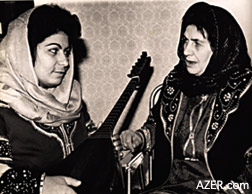  Left: Gulara Azafli (from Tovuz, who currently lives
in Baku) with Narinj Khatun (from Neftchala) during a performance.
Photo: 1980s. Courtesy: Gulara Azafli. Left: Gulara Azafli (from Tovuz, who currently lives
in Baku) with Narinj Khatun (from Neftchala) during a performance.
Photo: 1980s. Courtesy: Gulara Azafli.
Upon arrival, I witnessed the great respect with which local
dignitaries met this group. Hundreds of admirers had crowded
into the auditorium in anticipation of the three-hour performance.
The Ashug Pari Majlisi is an organization of women ashugs and
"el shairlari" (folk poets who write in the ashug style
but don't accompany themselves on the saz). The group was born
out of the vision and hard work of Narinj Khatun (Narinj Aziz
gizi Jafarova), a remarkable poet, who had succeeded in publishing
verse in regional newspapers when she was still in her early
teens.
Back in the early 1980s, Narinj Khatun traveled around Azerbaijan
as well as to the Azerbaijani communities in Georgia and Armenia
to galvanize women ashugs and folk poets. This was the first
time this had ever been done and Narinj Khatun worked tirelessly
to promote her fellow artists' talent. She named the organization
after Ashug Pari, Azerbaijan's first great woman ashug (believed
to have lived from 1811-1835), who was the center of a community
called a "majlis" where ashugs refined their skills
by playing and competing together. According to Narinj Khatun,
women artists had few possibilities to perform and publish at
that time, but Ashug Pari Majlisi provided support and gave its
members opportunities to perform, travel to concert venues, appear
on television, and see their poetry in print.
 |
 |
Above: 1. Members of Ashug Pari Majlisi and
friends at their first television appearance in 1985. First row,
from left: (1) Ashug Kifayat, (2) Director Amir Husein Majidov,
(3) Ulduz Sonmaz. Back row: (1) unknown, (2) Gulara Azafli, (3-4)
unknown, (5) Chichak Mammadova, (6) Farida Hajiyeva, (7) Aziza
Jafarzade, (8) Fatima Israfilova, (9) Fargana Mehdiyeva, (10)
Zivar Azizgizi, (11) Zulfiyya Ashigli. 2. Members of the Ashug
Pari Majlisi in Borchali (Georgia) with Georgian ashugs and poets.
Courtesy: Gulara Azafli.
Bolstered by well-known cultural
figures such as writer and folklorist Aziza Jafarzade [See this
issue] and poet Husein Arif, Ashug Pari Majlisi quickly earned
the love and respect of Azerbaijani audiences. Today under the
wise and loving guidance of Ashug Gulara Azafli (daughter of
Mikayil Azafli, one of the most famous Azerbaijani ashugs of
the 20th century), Ashug Pari Majlisi continues to hold live
concerts and perform regularly on television. They have also
recently published a new book called Ashug Pari Majlisi, which
is a collection of their writings.
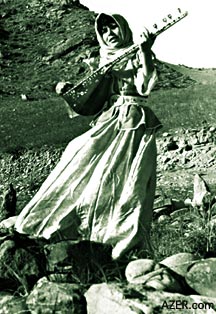  Left: Ashug Gurbaji. Photographed by the poet Husein
Arif, probably in the region of Tovuz in the northwestern Azerbaijan.
Courtesy: Farida Hajiyeva. Left: Ashug Gurbaji. Photographed by the poet Husein
Arif, probably in the region of Tovuz in the northwestern Azerbaijan.
Courtesy: Farida Hajiyeva.
Ashug Pari Majlisi has more
than 60 members. They are a diverse group of women whose ages
range from 16 to 60 plus. They are mothers and grandmothers,
professors, professionals, and housewives. Some are well-known
established performers; others are novices just starting their
careers.
The women ashugs come from all over Azerbaijan, including Karabakh
and the surrounding areas, some of which are now under Armenian
military occupation. Some have come from Goycha, an area now
located in Armenia, from which the Azerbaijani population was
forced to flee around 1988. Like Borchali in Georgia, both Karabakh
and Goycha had strong local ashug traditions.
In addition to traditional songs (taken from dastan and from
the poetry written by ashugs of the past), the poets of the Majlis
produce new poetry on a variety of themes, including philosophical
and spiritual topics, love for family, the beauty of nature,
love for their Homeland, and sorrow for the many tragic events
Azerbaijan has suffered over the recent years. The Majlis provides
numerous venues for women to perform, as well as serving as a
school for the arts, where younger artists can learn from older
masters, where new poems are enthusiastically discussed by all,
where new creative possibilities are discovered, where all members
have a chance to discover themselves and blossom as creative
artists and performers. In addition, the group provides strong
emotional support.
  It's
not easy for the group to stay active under the current economic
conditions in Azerbaijan. In the past, the Ministry of Culture
mostly supported many of their activities, such as concerts,
music recordings, television appearances and books. It's
not easy for the group to stay active under the current economic
conditions in Azerbaijan. In the past, the Ministry of Culture
mostly supported many of their activities, such as concerts,
music recordings, television appearances and books.
These days, they mostly have to find their own funding. The Majlis
operates by gathering money from its members and occasionally
from sponsors, but lack of adequate funding curtails their ability
to publish and perform more often.
Members make their own costumes and design their own stage props.
But many of them are supporting families and cannot afford to
publish books of poetry and song or produce cassettes or CD.
The cost of renting a large hall these days is so exorbitant
that the price of the tickets would demand more than the average
person could afford. And yet, because of the determination and
hard work of its leaders and members, Ashug Pari Majlisi persists.
Above:
Ashug Pari Majlisi. Baku
2004. Left to right: Saadat Buta, Zohra Khalili, Shargiyya Zangilanli,
Rafiga Goychali, Fargana Mehdiyeva, Parvana Zangazur, Gulnigar
Rahimli.
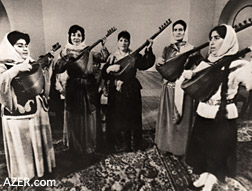  Left: (left to right) Gulnara Azafli, Ulduz
Sonmaz, Pakize Musakoylu, Aybaniz Lachinli, Fanara Mohubbatgizi. Left: (left to right) Gulnara Azafli, Ulduz
Sonmaz, Pakize Musakoylu, Aybaniz Lachinli, Fanara Mohubbatgizi.
The importance of this union in promoting the living tradition
of ashug art cannot be underestimated. By remaining in the public
eye, the group provides an important model of strong, creative
women and inspires young women and girls to become involved in
traditional culture. Younger members have told me that they grew
up dreaming of becoming a member of Ashug Pari Majlisi.
Although the organization depends upon the tireless volunteer
work of its members, the performances are of the highest professional
level and often leave one breathless. As Gulara Azafli described
so aptly: "Ashug art is beautiful and our women ashugs are
beautiful.
Together, they are even more beautiful." Watching these
talented women performing in national dress, playing saz with
expert mastery, and reciting powerful inspirational poetry in
honor of Narinj Khatun on that rainy November day, I found myself
hoping that someday not only Azerbaijan, but the international
community would be able to appreciate the depth and passion,
which goes into bringing this ancient art to life in the present
day.
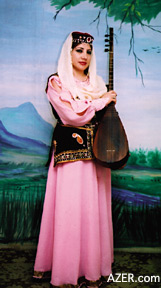 |
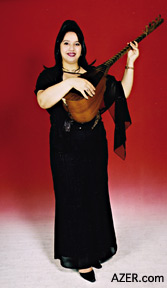 |
Above: Young ashugs, (left) Latifa Cheshamli
and (right) Kamala Gubadli. Both are members of the Ashug Pari
Majlisi.
Focusing my video camera, zooming
in on fingers flying over the saz fret board, I set to work trying
to make my own, small contribution to this goal. Author Anna
Oldfield Senarslan is in Baku on a Fulbright Scholarship from
the University of Wisconsin where she is working on her doctoral
dissertation to investigate Women Ashugs of Azerbaijan. Anna
is also working with Shovkat Jabbarova and other members of Ashug
Pari Majlisi to set up a Web site to feature ashug music and
poetry. They hope to launch it by late spring 2005.
Back to Index AI 12.4 (Winter
2004)
AI Home
| Search | Magazine
Choice
| Topics
| AI Store | Contact us
Other Web sites
created by Azerbaijan International
AZgallery.org | AZERI.org | HAJIBEYOV.com
|









